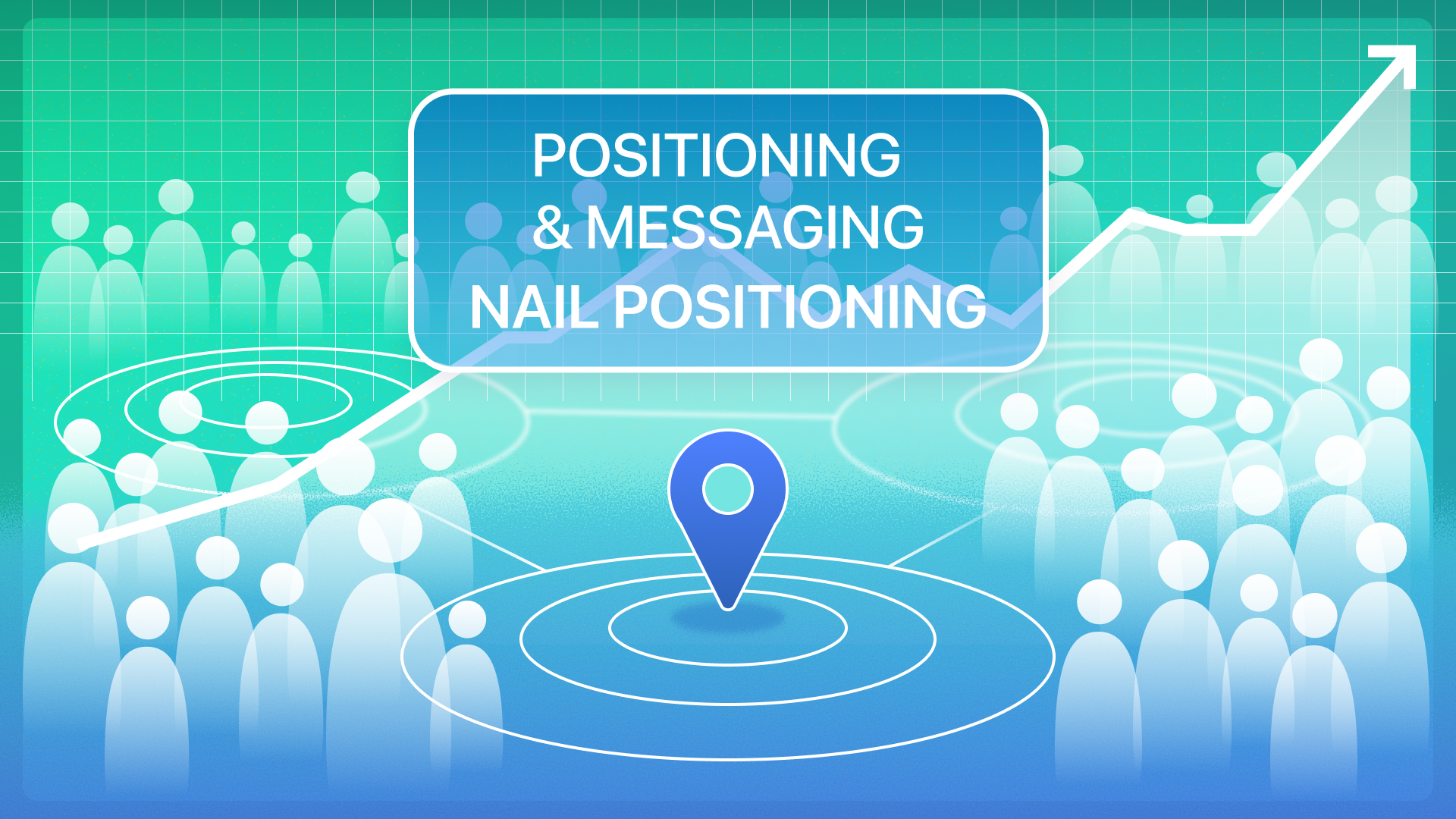The unexpected Series A inflection point
The best Series A pitch deck promises hockey stick growth through sales team expansion. The best Series A execution does the opposite: it slows down to nail positioning before scaling.
First Round Capital studied hundreds of B2B startups and found a consistent pattern: after launching a working product, companies typically spend 9-18 months iterating before reaching product-market fit. Those critical months are spent almost entirely refining one thing that most founders undervalue: positioning.
When Jason Lemkin analyzed why 80% of startups die between $1M and $10M ARR, he discovered something counterintuitive. The companies that survived didn't hire better salespeople. They had clearer positioning.
This creates a fundamental paradox at Series A. Investors push you to build a sales team. Your board wants to see hockey stick growth. But without clear positioning, every sales hire fails, every marketing campaign underperforms, and your burn rate accelerates toward zero.
The truth is uncomfortable but essential: you cannot hire your way out of unclear positioning. And most founders discover this only after burning through their Series A.
When the same product suddenly starts selling
Clay's journey illustrates the positioning problem perfectly. In 2022, they positioned themselves as "spreadsheet that fills itself" The description was technically accurate but strategically confusing. They were competing with everything from Excel to Salesforce. Prospects couldn't place them. Sales cycles dragged.
Then they repositioned as "data enrichment for scaling personalized outreach" in 2024. Same product, completely different framing. Suddenly, every RevOps team understood exactly what Clay did and why they needed it. The product didn't change. The capabilities didn't change. But sales velocity transformed overnight.
This pattern repeats across successful Series A companies. Ramp's founder Karim Atiyeh describes finding "message-market fit" before product-market fit: "We were able to differentiate and have people be interested in our unique messaging, but we didn't have the product there yet." They spent months refining how they positioned the product before building most features.
The difference between companies that scale and those that stall:
Stalled companies try to document a sales process before positioning is clear. They hire salespeople who create their own narratives, fragmenting the message.
Scaling companies nail positioning first, making sales naturally documentable. Everyone tells the same story because the story itself is clear.
The three layers of positioning maturity
After analyzing positioning patterns across 80+ early-stage companies, a clear progression emerges:
Feature soup ($0-1M ARR)
You describe everything your product does. Your website has 15 value props. Sales calls meander through capabilities. Every customer uses you for something different. This works when founders sell because they can adapt the story in real-time. It fails the moment anyone else tries.
Use case clarity ($1-3M ARR)
You identify the primary job your product does. You might still serve multiple customer segments, but you have a clear answer to "what problem do you solve?" This is where most companies get stuck. They have clarity but not precision.
Segment traction($3M+ ARR)
You own a specific problem for a specific buyer. Not "we help with productivity" but "we help account executives extract intent signals from prospect calls." This precision enables true repeatability.
Most companies try to hire sales while stuck in Feature soup. They wonder why their experienced sales hires can't close deals the founder could. The answer is simple: the founder is translating positioning in real-time, something a sales person can’t do with the same pattern recognition and product expertise.
The language your market adopts becomes your moat
Positioning isn't just about what you say. It's about creating language that markets adopt. When your terminology becomes how buyers describe their problem, you've achieved positioning dominance.
Consider how successful companies create linguistic frameworks:
Glean didn't build "enterprise search." They created "Work AI" to distinguish from general-purpose AI assistants like ChatGPT. This wasn't just semantic. Putting AI to work implied integrating and serving those enterprise systems rather than taking them over. The positioning attracted IT leaders who were nervous about consumer AI tools..
Replit didn't just add AI to their IDE. They created the "AI development environment" as a new category beyond traditional IDEs. They made the case that AI shouldn't be a plugin but the foundation of how development environments work. Now other IDEs describe their AI features using Replit's framing.
The pattern is clear: companies that successfully scale beyond founder-led sales don't just position products. They position entire problem spaces.
They give buyers new language to describe challenges they couldn't articulate before.
The positioning-first GTM framework
Based on analysis of successful Series A to Series B transitions, here's a framework that can help with positioning:
Positioning discovery
Run 20-30 customer interviews focused solely on problem articulation. Not product feedback. Problem articulation. Document the exact words customers use. Look for patterns in how they describe their pain.
Test three distinct positioning angles with 5 prospects each. Measure which generates the shortest explanation time and highest engagement. Don't try to be comprehensive. Try to be clear.
Message validation
Develop your messaging hierarchy: one-liner, three value pillars, transformation story. Test each element independently through landing pages, email campaigns, and sales calls.
Create what April Dunford calls "sales pitch positioning": the sequence of statements that consistently generates "aha" moments. Document the exact transition points where prospects lean in.
Language creation
Develop 3-5 proprietary terms that reframe the problem space. Not jargon, but genuinely useful language that helps buyers think differently. Publish content using these terms.
Build "teaching decks" not sales decks. Help buyers understand the problem before you pitch the solution. When prospects start using your problem framework, they're pre-sold on your solution.
Scale preparation
Hire two junior reps who've sold at your price point. Give them your positioning playbook. If they can achieve 50% of founder productivity within one sales cycle, you're ready to scale.
The uncomfortable truth about founder involvement
Seth DeHart, who's advised 80+ B2B startups through this transition, states it bluntly: "There is no transition 'out of sales.' The roles transition, but at least one founder is the steward of revenue for the company. Forever."
This doesn't mean founders do every sales call forever. It means founders own positioning forever. Because positioning isn't a document or a project. It's the continuous process of ensuring your company's story evolves with the market.
Successful founders stay involved in three ways:
- Strategic deals: They join calls where positioning might need real-time adjustment
- Message evolution: They personally test new positioning angles with prospects
- Narrative ownership: They ensure all teams tell the same story consistently
The companies that successfully scale maintain founder involvement in positioning while delegating execution. The companies that fail try to delegate both.
Actual companies achieving scale through positioning alone
Case study: Notion AI's relationship reframe
When Notion added AI features in 2023, they could have called it an "AI writing assistant" like everyone else. Instead, they positioned it as an "AI thought partner." The difference is meaningful. Assistants help you execute. Thought partners help you think. This positioning justified deeper integration and higher pricing because the value wasn't just efficiency but intelligence augmentation.
Case study: Cursor's capability positioning
Cursor could have positioned as "AI-powered IDE" or "the future of coding." Instead, they chose "the IDE that understands your entire codebase". This specificity attracted enterprise teams working on complex systems where context matters more than speed. The positioning enabled premium pricing (teams pay more for comprehensive understanding) and faster enterprise sales cycles (IT departments could evaluate a specific capability rather than vague AI promises).
The metrics that matter
Start measuring positioning strength:
Time to first value articulation: How long does it take a prospect to understand what you do? Track explanation time in sales calls. Under 2 minutes is good. Under 1 minute is great.
Prospect language adoption: What percentage of prospects use your terminology by the end of a call? When they start using your words, they're buying into your worldview.
Competitive win rate by segment: Where do you win consistently? That's where your positioning resonates. Double down there before expanding.
Inbound message alignment: Do inbound leads describe problems using your framework? If not, your market education isn't working.
The path forward at Series A
Your Series A creates both pressure and opportunity. The pressure to hire sales quickly is real and sometimes necessary. But hiring without enabling is setting everyone up for failure.
The companies that successfully transition from founder-led sales to scalable GTM understand a critical truth: sales teams need more than quotas and territories. They need clarity on who to sell to, what problem they solve, and how to articulate value consistently. This is positioning, and it's the difference between a sales team that struggles and one that scales.
The most successful approach combines strategic hiring with positioning investment. Enable while you build. If you hire sales early, dedicate equal resources to positioning and messaging. Your sales team becomes part of the positioning process, testing messages in market and providing real-time feedback. Document as you grow. Every sales conversation should inform your positioning.
Frequently asked questions
Q: How do we know our positioning is clear enough to start scaling?
A: Run the "stranger test." Can someone who's never heard of you understand what you do from your homepage in 30 seconds? Can a new sales hire not only explain your value prop after one day of training but explain why it matters? Can customers tell other potential customers what you do in a way that makes the pain you solve feel obvious? If all three are yes, you're ready.
Q: What if our current customers use us for different things? How do we evolve our positioning without losing them?
A: Keep existing customers supported with post-sales content, account outreach, and in-product signposts so their workflows stay intact. For new customers, double down on the use case with the clearest pain and fastest win rate, and position acquisition around that. Existing customers won’t churn because your website copy changed but new ones will close faster because your value is more targeted.
Q: Can we do positioning work while building the sales team simultaneously?
A. Yes, but hire with the right expectations. Salespeople without a clear story will create their own, which fragments your message. If you bring them on early, ask them to help test and pressure-test positioning in real customer conversations. Once the positioning is locked, reset expectations and shift them into a true sales role.



